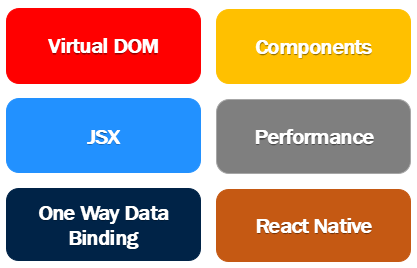ReactJS introduction
In this ReactJS introduction, we will learn
- What is React?
- React journey so far.
- Prerequisites to learn React.
- React important features.
What is React?
React is an Open Source JavaScript library used for creating dynamic and interactive user interfaces for mobile and web applications. It is highly flexible, declarative and efficient for developing scalable, simple, and fast front-end for web & mobile applications. In simple terms, React JS effectively handles the view layer of mobile and web application.
React is flexible in such a way that, in any application, we can use as little or as much React as you need. For example, react can be used in any existing web application to develop a new feature or even the application’s entire UI.
React is only concerned with rendering data to the Document Object Model (DOM) and so creating React applications usually requires the use of additional libraries for implementing things like state management and routing which we will discuss in our upcoming videos.
ReactJS has become highly popular across the globe because of its extra simplicity and flexibility. Many people are even referring to ReactJS as the future of web development.
Part of this huge popularity comes from the fact that top corporations such as Facebook, PayPal, Uber, Instagram, Airbnb etc use it to develop the user interfaces.
React Journey
React was created by Jordan Walke, who is a software engineer at Facebook, It was first deployed on Facebook's News Feed in 2011 and later on Instagram in 2012. It was open-sourced at JSConf US in May 2013.
- React Native, which enables native Android and iOS development with React, was announced at Facebook's React Conf in February 2015 and open-sourced in March 2015.
- On April 18, 2017, Facebook announced React Fiber, a new core algorithm of React library for building user interfaces. React Fiber was to become the foundation of any future improvements and feature development of the React library.
- Like any other Library or Framework, even React has several versions as part of its evolution and 16.12 is the Current Release and we will discuss the various versions available in React and their important changes in our upcoming tutorials.
Prerequisites to learn React
- HTML
- CSS
- Knowledge of JavaScript and ES6(let and constant, classes and Arrow functions)
- Basic Knowledge of Node and npm
We will discuss the basics of Node and NPM in our upcoming videos when we setup React

Virtual DOM:
The most important and biggest feature introduced by React is Virtual DOM. In React, as a developer, we work with Virtual DOM instead of working directly with Real DOM. This will be discussed in our upcoming videos in detail.
Components:
In react, every application UI is broken down into Components. The component is the most basic building block of the Application UI.
JSX:
JSX stands for Javascript Syntax Extension. React uses JSX for building templates instead of regular JavaScript. It is not necessary to use it when we are working with React but JSX makes React a lot more elegant. This feature makes it much better than many other frameworks out there today.
One-way data-binding:
React JS follows one-way data binding or unidirectional data flow that gives better control throughout the application.
React Native:
React Native is an open-source mobile application framework while React is for websites(front-end). In React JS, React is the base abstraction of React DOM for the web platform, while with React Native, React is still the base abstraction but of React Native. So the syntax and workflow remain similar, but the components are different.
Video Reference:
Video Slides :
© 2020 Pragimtech. All Rights Reserved.

